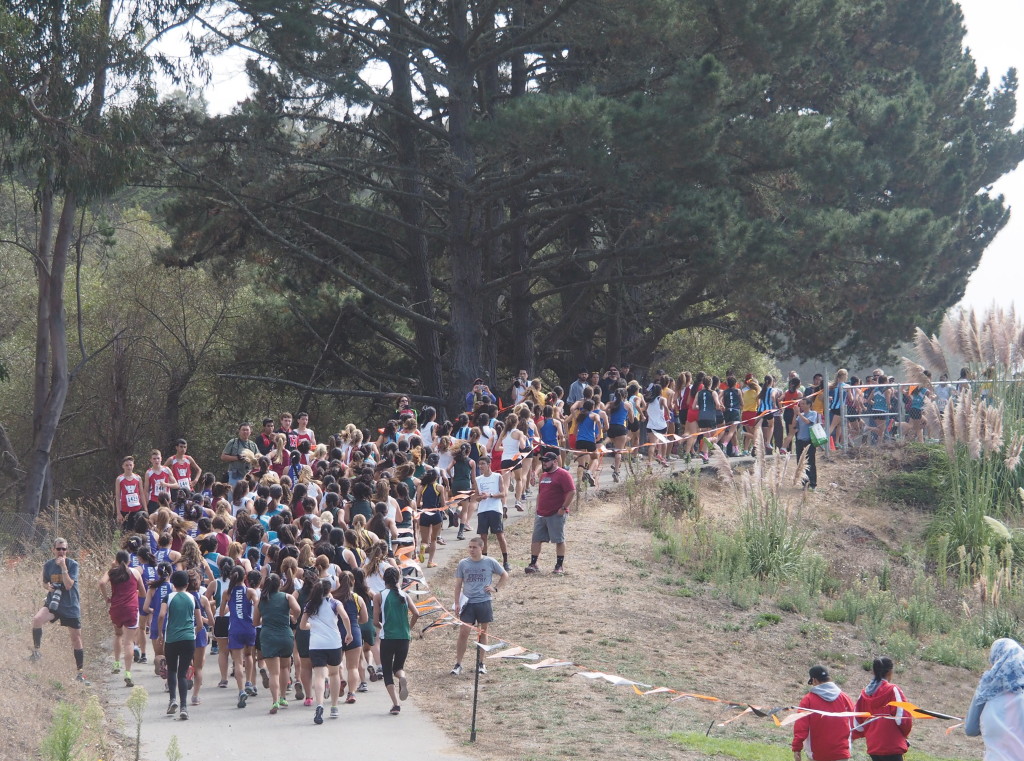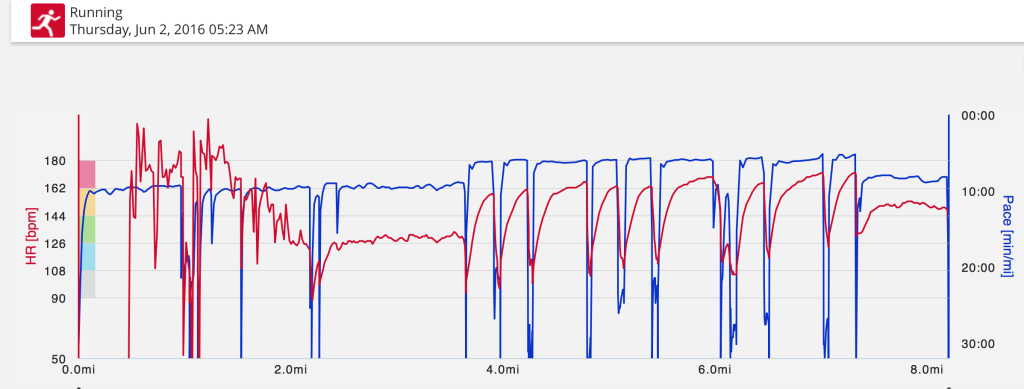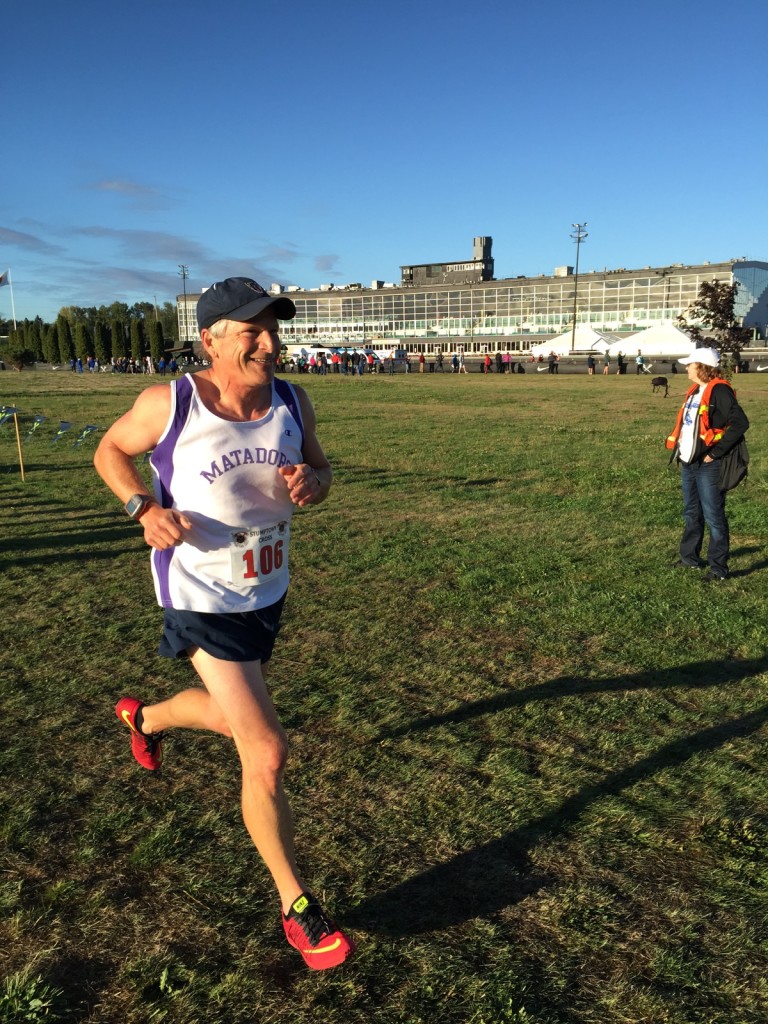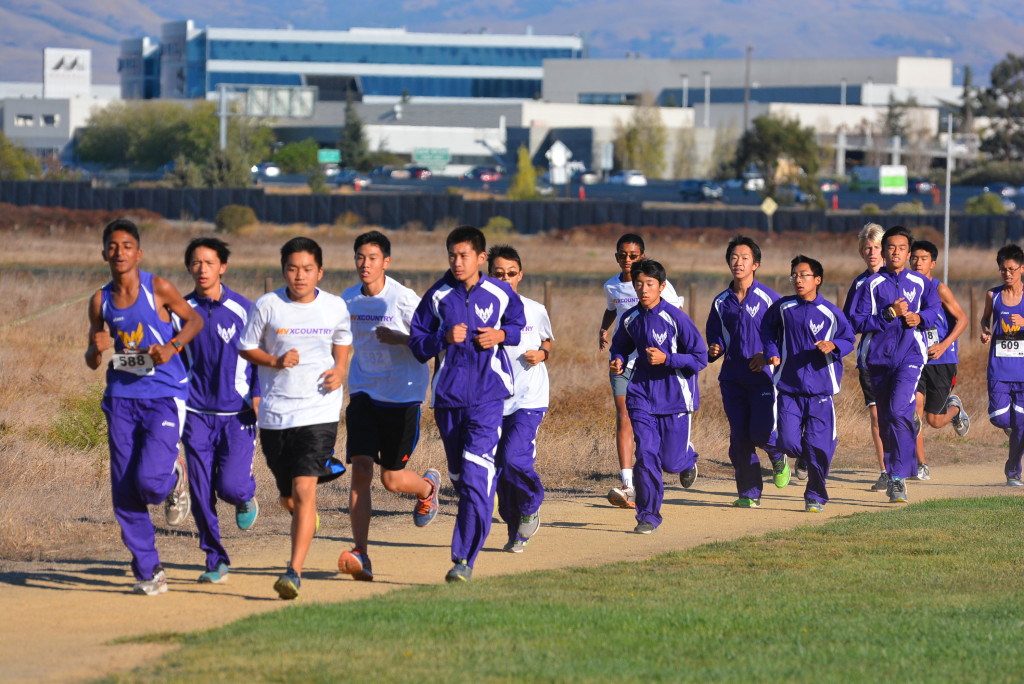
How many of these athletes have warmed up enough before starting their race?
As many of the athletes in MVXC16 know, at the urging of the MIT track & field coach, I’ve passed out a few heart rate monitors and am using one myself. As I use my HR monitor and look at the results, I’ve been getting quite a bit of data that I did not have before. This new information is spurring me to think more deeply about what is going on. One of the areas I’ve looked at is warming up…today I’m going to share a bit about what I’ve learned about our warm-ups before workouts or competition.

Above is a screen shot from my Polar M400, recording the data for my morning track workout on June 2*. During the first two miles of the workout, the red heart rate line looks like it is recording a cardiac event! While the MVXC athletes might think that their old coach having a slight heart attack at the start of every run is normal, I don’t! I feel like those heart rate fluctuations mean that there is more going on, so I decided to do a little research into the physiology of the warm up.
The Warm Up
The warm up before a workout or a race addresses two major objectives, (1) to increase performance and (2) to reduce the risk of injury. This discussion is going to focus on (1), but I don’t want to discount (2). Avoiding an injury is a key goal for all of us, primarily because it hurts me to see any of my athletes hurt, but also because if you are not hurt you are more likely to be able to continuously train, enjoy your training, and achieve your goals! An athlete’s greatest ability is availability. However…much of what we will discuss in this post relates to performance in our workout or race.
When you are sitting around (such as right now as you read this post!), the energy requirements of your working muscles are low, and so blood flow is distributed widely through your body. When we get up and start running, the energy demands (and hence oxygen demands) of our working skeletal muscles and respiratory muscles increases dramatically. Blood vessels to our working muscles will dilate (vasodilation) to increase blood flow, and blood vessels to peripheral organs (kidneys, intestines**, and non-working skeletal muscles) will close down (vasoconstriction) so that more blood is sent where it is needed.
This process of re-routing your blood flow takes time, and during this time you might not feel tip-top and if you are like me this morning, your heart rate might fluctuate as your body adjusts to the new workload. Looking at the data from my session, it took me two miles before my heart settled down to 125-135 BPM even though my pace for the two miles stayed roughly the same. My perceived effort, though, continued to decrease as I warmed up even though my pace did not change, and the heart rate record provides hard data that my body was adapting to the new workload. I have not been able to find any definitive data on how long this process takes for most people, and how much age, training and conditioning, health or other factors effects the time required for our bodies to make this adjustment. You and I are probably different, but the message is constant–we both need a warm up for our bodies to prepare for a harder effort.
There are other interesting physiological changes taking place during the warm up, that would not show up in a heart rate monitor:
- Pay attention chem students, there are some really interesting changes taking place! As blood temperature increases, the partial pressure of blood gases changes, leading to a disassociation of oxygen from haemoglobin and myoglobin; at the same time, concentration of hydrogen ion and CO2 in muscles and organs changes. If you are not a chem student, relax–here is the bottom line: The result is that oxygen extraction from blood to skeletal muscles increases from 20-40% during rest to 70-80% during heavy exercise.
- The increase in muscle temperature makes muscles more pliable, so muscles are more energy efficient (as well as being less prone to injury). The increased temperature leads to an increase in enzyme and metabolic activity, increasing power and efficiency of muscle contraction.
- Central nervous system control of the muscles becomes more active. This activation of neural pathways, will speed up reaction time and efficiency later on during your workout or race.
Warming up together is always a good idea!
If Your Eyes Have Glazed Over…Please Read This
If you are not interested in the science of warm ups and exercise, don’t worry. What I’m trying to communicate to you is that warm ups are important, and there is SCIENCE that backs up the importance of your warm up. Your coach ranting and raving and yelling at you to warm up more for a reason; this is science! Look back at my heart rate graph, and think about what the body is doing during those first couple of miles or first couple of dozen minutes. Your body is making physiological changes from rest mode to attack mode. If you take off ripping into your race before your body is ready, bad things can happen–not just getting hurt. Your body is not ready to function efficiently, you are going to feel poorly, you are not going to get adequate oxygen to your muscles, your body is not going to process lactic acid efficiently, and you are not going to be able to dig yourself out of the hole.
If you do not take the time to warm up properly, you are doing yourself a disservice. All the time and miles you put into preparing for a race are not going to be expressed in your race result. Have you ever run a race and thought, “I felt bad that entire race”? Maybe you were not warmed up, put your body under stress it was not ready for, your heart rate started bouncing around as your body tried to catch up, you were not getting adequate O2 to your working muscles, and everything spiraled down worse and worse. Think about what a shame it would be to run hundreds of miles all summer, and hundreds of miles all season, and then you have a bad race because you got distracted talking to friends for a half hour at Leagues and did not warm up adequately!
How much should you warm up? I wish I could give you an exact answer. I have not found a definitive answer in any literature (if I find an answer, I’ll let you know). My observation is that most high school athletes do not warm up enough. My personal belief is that warming up a little too much is almost never a problem (the one possible exception is in extremely hot weather), while warming put too little can be a killer. The graph of my workout above shows that I am doing for myself what I am asking you to do. Even after my heart rate was starting to settle down at two miles, I ran almost two additional miles before beginning my workout. I benefit both from getting more total volume as well as being well warmed up before my workout starts.
For all of us, there are a few lessons:
- Make sure we warm up adequately to get the most out of workouts and to race well.
- A HR monitor might help us learn more about how our bodies react during a warm up.
- When in doubt, add a bit. If you are not sure whether you have warmed up enough, maybe it’s better to be safe and warm up a little more (unless it is a very hot day–then being conservative with your warm up might be a better choice). If you are building volume, this is a great time to add another mile for the day (and encourage a teammate too!).
And of course…you can always talk to your coach about warming up! Warming up is not just a good idea…it’s freaking science!

Look for More Posts
This summer, I’m planning on writing a little more about a couple of related topics:
Warm Up Activities: What about strides and drills? Are they important during warm ups, when to include them?
Using Your Heart Rate Monitor During Workouts: What is the monitor telling me, how could I be using this data?
More Reading
As I was writing this post, I was referring to the following source data, as well as going back to notes from my IAAF course. There are a lot of conflicting positions that scientists and writers take about what is going on physiologically, but I feel comfortable with the conclusions that warm ups are important, even if not everyone completely agrees with what the most important physiological reasons are for the importance of the warm up.
I do think all of this is incredibly interesting. We have many student-athletes who have an interest in biology, chemistry, medicine as well as a love for running–you might find a passion in studying the physiology of training and exercise theory. No matter what some of these people say, there are a lot of interesting unanswered questions here! That means lots of great opportunities for you to add to our collective running wisdom.
Also, thank you to Coach Halston Taylor at MIT, who encouraged me to incorporate heart rate information into training and who had many comments that have worked there way into the way I think about this information. I’m sure he recognizes phrases in this post that came from him.
National Institute of Health: Exercise Hyperermia and Regulation of Tissue Oxygenation During Muscular Activity
Cardiovascular Physiology Concepts: Skeletal Muscle Flow
Runners’ World: Warm Up Tips
Science of Running: The Warm Up

This looks like a coach that had an adequate pre-race warm up!
*Yes, I did start my track workout today at 5:23am. For inquiring minds…the workout was 3x(2x400m+800m), though I did miss one of the 400s and added it back at the end.
**Decreased blood flow to our intestines is why our ability to absorb water decreases while we exercise. This is why your coach nags and nags you about hydration all day long, so you are well hydrated before you start running your workout or race. Your ability to absorb water decreases dramatically when you are running or racing, so you need to be sipping water all day long BEFORE you start exercising. During exercise, you can continue to sip water, but you can’t absorb the same large quantities that you can while resting.

